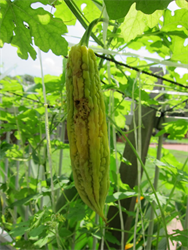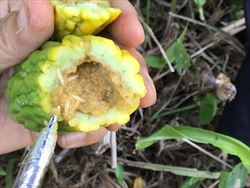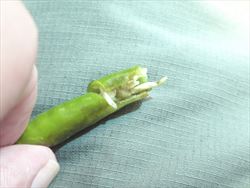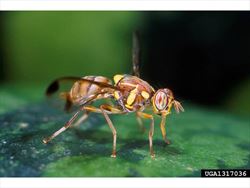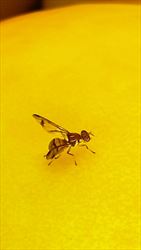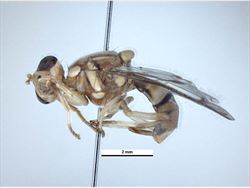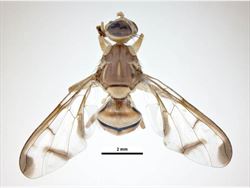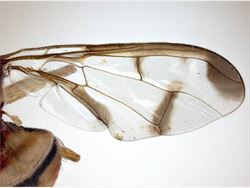Melon fly
Pacific Pests, Pathogens, Weeds & Pesticides - Online edition
Pacific Pests, Pathogens, Weeds & Pesticides
Melon fly (505)
Zeugodacus cucurbitae; known previously as Bactrocera (Zeugodacus) cucurbitae, and Bactrocera cucurbitae.
Asia, Africa, North America (Hawaii). It is recorded from Australia, including Christmas Island, Guam, Nauru, Northern Mariana Islands, Papua New Guinea, Solomon Islands, and Timor-Leste.
Mostly on cucurbits (Cucurbitaceae); among the most important commercial hosts in this family are: bitter gourd (Momordica charantia); cucumber (Cucumis sativa); ivy gourd (Coccinia grandis); luffa (Luffa species); marrow and zucchini (Curcurbita pepo); melon (Cucumis melo); pumpkin (Curcurbita maxima); snake gourd (Trichosanthes cucumerina); watermelon (Citrullus lunatus); and wax gourd (Benincasa hispida). Many wild species are also hosts in the cucumber family. Hosts in other families include bean (Fabaceae), capsicum, chilli and tomato (Solanaceae).
A major pest with a wide host range among many commonly-grown crops. It has a short life cycle of 3-5 weeks (but can be several months depending on temperatures), and spreads quickly once introduced (Diagram). Damage is done when eggs are laid in both flowers and fruit, often called a 'sting'. As female lay eggs, bacteria, carried by the adult flies, are inserted at the same time; these rot the flesh suppling food for the maggots (Photos 1-4). Rots in fruits may be extensive before they are noticeable from the outside. Often, early symptoms show premature ripening where the eggs are laid (Photo 1). Young fruit often fall, and mature fruit develop a water-soaked look.
Eggs are about 2 mm long; larvae, 7.5-9 mm long, white, typical of other tephritid fruit flies; pupae, dull red to brownish-yellow, 5-6 mm long. Pupation occurs in the soil. Adults are orange-brown, 6-8 mm long, a little longer than a house fly, but more slender, with three yellow stripes on the thorax (Photos 5-7). There is a T-shaped marking (sometimes incomplete) on the abdomen (Photo 8). Importantly, there are roundish, indistinct, smoky-brown markings (circular blobs) at the tips of the wings and similar fuzzy marks at the back of the wings bordering a vein (Photos 9&10). Females lay about 1000 eggs; adults live for up to 15 months.
Spread occurs by flight - adults are strong flyers - with dispersal flights of several tens of kms recorded in Northern Mariana Islands and Japan (one record suggests 265 km over water!). Larvae spread in infested fruit carried by people, sent in mail or with trade across borders.
Melon fly is considered the most destructive pests of cucurbits, with severe damage reported from Hawaii (melon, cucumber and tomato), Solomon Islands (80% snake gourd and 60-85% pumpkin) and Papua New Guinea (95% bitter gourd). Losses of melon in the Philippines (Luzon province) have been reported to range from 5 to 40%.
Infestation results in crop losses, loss of export markets, and/or costly treatments to ensure compliance with quarantine measures imposed by importing countries. If treatments involve the use of pesticides, then there is the risk of impacts to the environment as well as human health. Furthermore, the value of horticultural industries leave countries with no option but to attempt eradication if introduction of melon fly should occur. California, for instance, estimated the value of crops susceptible to melon fly as over $4.5 billion in 2008, and that was without including backyard-grown fruit. However, the cost of eradication can be enormous. It is estimated that it cost Japan Euro200 million to eradicate melon fly from the Ryukyu Islands.
Look for the smoky-brown markings at the tips and backs of the wings (Photos 8&9). Look for the T marking on the abdomen (Photo 7). Melon fly is attracted to Cue-Lure. Because of the similarity of this fruit fly to others (e.g., Queensland fruit fly, see Fact Sheet no. 425), it is important that specimens are examined by a taxonomist familiar with the different species.
BIOSECURITY
Countries not yet infested by melon fly should consider all likely pathways for entry, and apply quarantine measures accordingly. Fruit and vegetables may need to be treated to manage risk of fruit fly introduction by, e.g., HTFA - high-temperature forced-air, low temperature, insecticide dips, irradiation, area freedom, or area-wide management. Where melon fly is established but not uniformly distributed, or where countries are free from melon fly, but close to those infested, they may wish to consider biosecurity provisions that limit the free movement of produce known to harbour melon fly within their own borders.
Melon fly is on the EPPO A1 list, as it is absent from the region and recommended for regulation as a quarantine pest.
BIOCONTROL
Waterhouse summarises the situation for Hawaii: "the most effective natural enemy of Bactrocera cucurbitae so far known is Psyttalia fletcheri, introduced from India, which causes a moderate level of mortality in Momordica [wild bitter gourd], but only limited mortality of larvae in cultivated fruit. ...further studies on Diachasmimorpha albobalteatus and especially D. dacusii might be warranted". Soil and ground-dwelling predators likely to be important mortality factors as larvae move out of fruit to pupate.
CULTURAL CONTROL
The most effective control strategies for this fruit fly are: i) monitoring, ii) crop hygiene and iii) protein-bait sprays.
Before planting:
- Do not grow susceptible crops one after the other on the same land. Pupae may survive in the soil to carry-over melon fly between crops. Rotate with, e.g., leafy vegetables, maize or non-host fruiting crops.
During growth:
- Monitor (scout crops twice a week):
- assess fresh damage caused by fruit fly attack:
- check fallen fruit, cut open and check for fruit fly maggots.
- check for egg-laying 'stings' on the surface of fruit
- collect and dispose of prematurely ripened fruit, fallen and overripe fruit
- use traps with Cue-lure to attract male flies in the area - a wick or wafer impregnated with pheromone. An insecticide may also be present (spinosad, spinetoram (same mode of action) or malathion) in the wick/wafer or added. (Note, the traps are not for controlling the fruit fly, but only to detect its presence)
- assess fresh damage caused by fruit fly attack:
- Crop hygiene
- use nets or bags for individual fruits when used after fruit set (especially useful for home gardens). Curtain mesh is ideal. The net must have a weave of about 2 mm x 1 mm to prevent entry by fruit flies. Make sure the net is not touching any fruit or they may lay eggs through the net, and so are brown paper bags. Brown paper bags or newspaper can also be used, although it may not last long in high-rainfall areas. As the method is labour-intensive, commercial growers should check whether the method is economically viable.
- The bags or net must be applied before the fruit is susceptible to attack, which in most cases is prior to fruit colour-break. However, some fruit, e.g., melons and solanum crops, are susceptible to attack at the immature, green stage.
After harvest:
- A number of methods can be used to destroy the remains of harvests:
- collect fruits left on trees, shrubs, vines, etc., bury them deeply in the soil, along with compacting the soil to squash the insects.
- destroy crop residues by boiling or burning.
- crush with a boot or plough into soil.
- place infested fruit in plastic bags, seal carefully, and leave in the sun for a few hours to kill the maggots, or freeze them for at least 24 hour.
- Do not compost or put infested fruit in garbage bins. The remaining plant debris can be used as a mulch or incorporated into soil.
ERADICATION
There have been many attempts at eradication of melon fly. This is usually done by (i) defining a quarantine area around the outbreak site (c.3 km), (ii) control of fruit movement, (iii) removal of fruit on infested crop and collecting fallen fruit, (iv) protein bait and insecticide sprays (to attract and kill male and female flies), (v) management of green waste, and vi) male annihilation technology (high density traps, 10-20 per ha, containing sex pheromone plus insecticide in compressed fibreboard or cardboard).
Sterile insect technology (SIT) is frequently applied after protein bait sprays and/or the male annihilation technique. Often the numbers of sterile insects needed to achieve eradication is considerable. For example, for successful eradication in three groups of islands in the Okinawa Prefecture, Japan, 6,340, 30,940 and 15,440 million sterile melon flies were released in the 1980s and 90s!
SIT was also successful in Rota, Tinian and Saipan of the Northern Mariana Islands (but subsequently melon fly was reintroduced to the NMI during a typhoon). Introductions to California have been eradicated, too. Eradication from Kiribati (Christmas Island) was achieved by a host-free period from 1987 to 1989, and from Nauru in 1999 by using male annihilation and protein bait sprays.
CHEMICAL CONTROL
Cover sprays over the entire crop have given way to protein bait sprays that are more economical, and less hazardous in the environment (see Fact Sheet no. 507).
- Use a protein bait (e.g., yeast autolysate from brewery waste) with an insecticide (e.g., malathion or spinosad in Australia; fipronil or spinetoram in other countries) to control both male and female fruit flies, applied weekly in spots or bands on stems, trunks, branches or foliage, from fruit set through to final harvest.
- Apply sprays every few metres along the rows, and onto the underside of bottom leaves of trees where the flies 'roost'. It is best applied weekly as it is susceptible to weathering.
- Apply to the underside of crop leaves if possible; the leaves protect the spots of spray from rainfall. The undersides of leaves is where the flies 'roost'.
- Note, a protein bait can be used in organic production if spinosad is the insecticide.
____________________
When using a pesticide, always wear protective clothing and follow the instructions on the product label, such as dosage, timing of application, and pre-harvest interval. Recommendations will vary with the crop and system of cultivation. Expert advice on the most appropriate pesticides to use should always be sought from local agricultural authorities.
AUTHORS Graham Walker & Grahame Jackson
Information from Allwood AJ, et al. (1999) Host plant records for fruit flies (Diptera: Tephritidae) in South-East Asia. The Raffles Bulletin of Zoology. Supplement 7. 92 pp. (Complete host list in Asia); and Allwood AJ, Drew RAI (1997) Management of fruit flies in the Pacific. ACIAR Proceedings No 76. 267pp.; and Melon fruit fly (Undated) Fact sheet. Plant Health Australia. (https://www.planthealthaustralia.com.au/wp-content/uploads/2013/09/Melon-fruit-fly-FS.pdf); and Anon (2020) Melon fly. Business Queensland. Queensland Government. (https://www.business.qld.gov.au/industries/farms-fishing-forestry/agriculture/crop-growing/priority-pest-disease/melon-fly); and The Australian Handbook for the Identification of Fruit Flies (2018) Plant Health Australia. Canberra, ACT. (Version. 3.1). (https://www.planthealthaustralia.com.au/wp-content/uploads/2018/10/The-Australian-Handbook-for-the-Identification-of-Fruit-Flies-v3.1.pdf); and Waterhouse DF (1993) Pest fruit flies in the oceanic Pacific. Biological Control Pacific Prospects - Supplement 2. ACIAR, Canberra; and Garcia FRM, et al. (2020). Biological control of tephritid fruit flies in the Americas and Hawaii: A review of the use of parasitoids and predators. Insects 11(10): 662. (https://pubmed.ncbi.nlm.nih.gov/32993000/); and from Yates. Fruit fly control in your garden (https://www.yates.com.au/plants/problem-solver/pests/fruit-fly/). Photo 1 Melon Fly (Zeugodacus cucurbitaceae). Scott Bauer, USDA Agricultural Research service, Bugwood.org. Photos 7-10 Walker K (2006) Melon Fruit Fly (Bactrocera cucurbitae). Museum of Victoria. PaDIL - http://www.padil.gov.au. Diagram McDougall S, et al. (2013). Tomato, capsicum, chilli and eggplant: A field guide for the identification of insect pests, beneficials, diseases and disorders in Australia and Cambodia. Australian Centre for International Agricultural Research (ACIAR). (http://aciar.gov.au/files/mn-157/index.html).
Produced with support from the Australian Centre for International Agricultural Research under project HORT/2016/185: Responding to emerging pest and disease threats to horticulture in the Pacific islands, implemented by the University of Queensland and the Secretariat of the Pacific Community.

